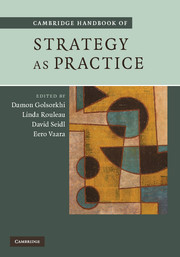Introduction: What is Strategy as Practice?
Published online by Cambridge University Press: 05 October 2012
Summary
Strategy as Practice as a research approach
In recent years, Strategy as Practice has emerged as a distinctive approach for studying strategic management, organizational decision-making and managerial work (Whittington 1996; Johnson et al. 2003; Jarzabkowski et al. 2007). It focuses on the micro-level social activities, processes and practices that characterize organizational strategy and strategizing. This provides not only an organizational perspective into strategy but also a strategic angle for examining the process of organizing, and thereby serves as a useful research programme and social movement for connecting contemporary strategic management research with practice-oriented organizational studies.
Strategy as Practice can be regarded as an alternative to the mainstream strategy research via its attempt to shift attention away from merely a focus on the effects of strategies on performance alone to a more comprehensive, in-depth analysis of what actually takes place in strategic planning, strategy implementation and other activities that deal with strategy. In other words, Strategy as Practice research is interested in the ‘black box’ of strategy work that once led the research agenda in strategic management research (Mintzberg 1973; Mintzberg and Waters 1985; Pettigrew 1973), but has thereafter been replaced by other issues, not least because of the increasing dominance of the micro-economic approach and a methodological preoccupation with statistical analysis. Because of its micro-level focus, studies following the Strategy as Practice agenda tend to draw on theories and apply methods that differ from the common practices of strategy scholars.
- Type
- Chapter
- Information
- Cambridge Handbook of Strategy as Practice , pp. 1 - 20Publisher: Cambridge University PressPrint publication year: 2010
References
- 33
- Cited by

